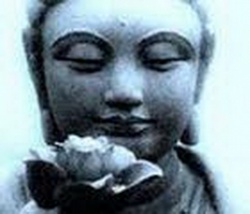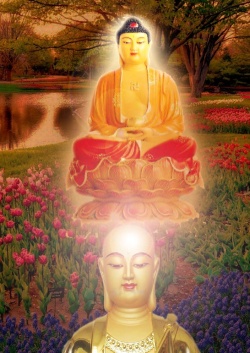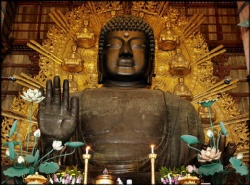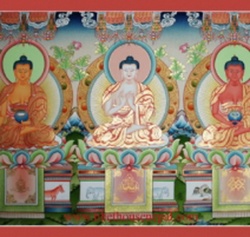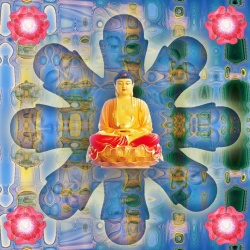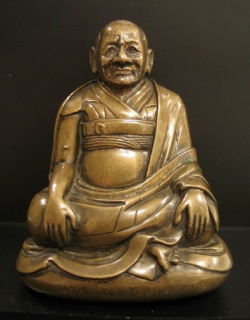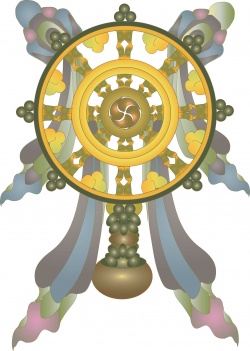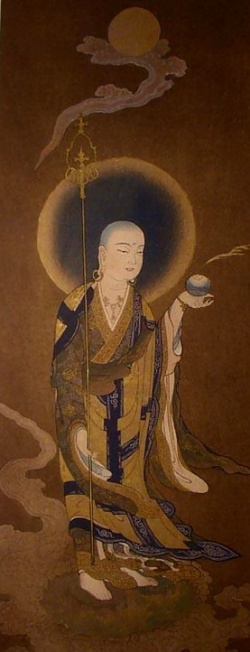Difference between revisions of "Sound"
(Created page with "thumb|250px| ''Shabda'', mantra or sound, which is of the Brahman, and as such the cause of the Brahmanda, is the manifestation of the Chit-shakti Itse...") |
m (Text replacement - "[[[" to "([[") |
||
| (7 intermediate revisions by 2 users not shown) | |||
| Line 1: | Line 1: | ||
| − | [[File:Ima145ges.jpg|thumb|250px|]] | + | [[File:Ima145ges.jpg|thumb|250px|]]<nomobile>{{DisplayImages|4131|759|1048|4341|1415|1666}}</nomobile> |
| − | |||
| − | |||
| − | |||
| − | A | + | |
| + | |||
| + | |||
| + | |||
| + | |||
| + | |||
| + | ''[[Shabda]]'', [[Mantra]] or [[sound]], which is of the [[Brahman]], and as such the [[cause]] of the [[Brahmanda]], is the [[manifestation]] of the [[Chit]]-[[Shakti]] Itself. | ||
| + | |||
| + | The [[Vishva-sara Tantra]] says that tha [[Para-Brahman]], as [[Shabda-Brahman]], whose [[substance]] is all [[Mantra]], [[exists]] in the [[Body]] of the [[jivatma]]. It is either unlettered ([[dhvani]]) or lettered ([[varna]]). | ||
| + | |||
| + | The former, which produces the [[latter]], is the {{Wiki|subtle}} aspect of the [[jiva’s]] [[vital]] [[Shakti]]. | ||
| + | |||
| + | As the [[Prapancha-sara]] states, the [[brahmanda]] is pervaded by [[Shakti]], consisting of [[dhvani]], also called [[nada]], [[prana]], and the like. | ||
| + | |||
| + | The [[manifestation]] of the gross [[Form]] ([[sthula]]) of [[shabda]] is not possible unless [[shabda]] [[exists]] in a {{Wiki|subtle}} ([[sukshma]]) [[Form]]. | ||
| + | |||
| + | [[Mantras]] are all aspects of the [[Brahman]] and [[manifestations]] of [[Kula-kundalini]]. {{Wiki|Philosophically}} [[shabda]] is the [[guna]] of [[akasha]], or [[ethereal]] [[space]]. | ||
| + | |||
| + | |||
| + | |||
| + | It is not, however, produced by [[akasha]], but [[manifests]] in it. [[Shabda]] is itself the [[Brahman]]. In the same way, however, as in outer [[space]], waves of [[sound]] are produced by movements of [[air]] ([[vayu]]); | ||
| + | |||
| + | so in the [[space]] within the [[jiva’s]] [[Body]] waves of [[sound]] are produced according to the movements of the [[vital]] [[air]] (([[prana-vayu]]) and the process of {{Wiki|inhalation}} and {{Wiki|exhalation}}. | ||
| + | |||
| + | [[Shabda]] first appears at the [[muladhara]], and that which is known to us as such is, in fact, the [[Shakti]] which gives [[Life]] to the [[jiva]]. | ||
| + | |||
| + | She it is who, in the [[muladhara]], is the [[cause]] of the [[sweet]] indistinct and murmuring [[dhvani]], which {{Wiki|sounds}} like the humming of a black bee. | ||
| + | |||
| + | |||
| + | |||
| + | The extremely {{Wiki|subtle}} aspect of [[sound]] which first appears in the [[Muladhara]] is called para; less {{Wiki|subtle}} when it has reached the [[Heart]], it is known as [[pashyanti]]. | ||
| + | |||
| + | When connected with [[buddhi]] it becomes more gross, and is called [[madhyama]]. Lastly, in its fully gross [[Form]], it issues from the {{Wiki|mouth}} as [[vaikhari]]. | ||
| + | |||
| + | As [[Kula-Kundalini]], whose [[substance]] is all [[varna]] and [[dhvani]], is but the [[manifestation]] of, and Herself the [[Paramatma]]; so the [[substance]] of all [[Mantra]] is [[chit]], notwithstanding their external [[manifestation]], as [[sound]], letters, or words; in fact, the letters of the [[alphabet]], which are known as [[akshara]], are [[nothing]] but the [[yantra]] of the [[akshara]], or imperishable [[Brahman]]. | ||
| + | |||
| + | This, however, is only [[realized]] by the [[sadhaka]] when his [[Shakti]], generated by [[sadhana]], is united with the [[Mantra-Shakti]]. | ||
| + | |||
| + | |||
| + | |||
| + | It is the [[sthula]] or gross [[Form]] of [[Kulakundalini]], appearing in different aspects as different [[Devata]], which is the presiding [[Devata]] ([[adhishthatri]]) of all [[Mantra]], though it is the {{Wiki|subtle}} or [[sukshma]] [[Form]] at which all [[sadhakas]] [[aim]]. | ||
| + | |||
| + | When the [[mantrashakti]] is [[awakened]] by [[sadhana]] the Presiding [[Devata]] appears, and when {{Wiki|perfect}} [[Mantra-Siddhi]] is acquired, the [[Devata]], who is [[sachchidananda]], is revealed. | ||
| + | |||
| + | The relations of [[varna]], [[nada]], [[vindu]], {{Wiki|vowel}} and consonant in a [[Mantra]], indicate the [[appearance]] of [[Devata]] in different [[forms]]. | ||
| + | |||
| + | Certain [[vibhuti]], or aspects, of the [[Devata]] are [[inherent]] in certain [[varna]], but {{Wiki|perfect}} [[Shakti]] does not appear in any but a whole [[Mantra]]. | ||
| + | |||
| + | Any [[word]] or [[letter]] of the [[Mantra]] cannot be a [[Mantra]]. Only that [[Mantra]] in which the playful [[Devata]] has revealed any of Her particular aspects can reveal that aspect, and is therefore called the {{Wiki|individual}} [[Mantra]] of that one of Her particular aspects. | ||
| + | |||
| + | The [[Form]] of a particular [[Devata]], therefore, appears out of the particular [[Mantra]] of which that [[Devata]] is the adhishthatri [[Devata]]. | ||
| + | |||
| + | |||
| + | |||
| + | |||
| + | A [[Mantra]] is composed of certain letters arranged in definite sequence of {{Wiki|sounds}} of which the letters are the representative [[signs]]. | ||
| + | |||
| + | To produce the designed effect [[Mantra]] must be intoned in the proper way, according to [[svara]] (rhythm), and [[varna]] ([[sound]]). | ||
| + | |||
| + | Their textual source is to be found in [[Veda]], {{Wiki|Purana}}, and [[Tantra]]. | ||
| + | |||
| + | The [[latter]] is [[essentially]] the [[Mantra]]-[[shastra]], and so it is said of the [[embodied]] [[shastra]], that [[Tantra]], which consists of [[Mantra]], is the [[paramatma]], the [[Vedas]] are the [[jivatma]], | ||
| + | |||
| + | [[Darshana]] (systems of [[philosophy]]) are the [[senses]], {{Wiki|Puranas}} are the [[Body]], and [[Smriti]] are the limbs. [[Tantra]] is thus the [[Shakti]] of [[Consciousness]], consisting of [[Mantra]]. | ||
| + | |||
| + | |||
| + | |||
| + | A [[Mantra]] is not the same thing as [[prayer]] or self-dedication ([[atma-nivedana]]). [[Prayer]] is conveyed in what words the worshipper chooses, and bears its meaning on its face. | ||
| + | |||
| + | It is only [[Ignorance]] of [[shastrik]] [[principle]] which supposes that [[Mantra]] is merely the [[name]] for the words in which one expresses what one has to say to the [[Divinity]]. | ||
| + | |||
| + | If it were, the [[sadhaka]] might choose his [[own]] [[Language]] without recourse to the [[eternal]] and determined {{Wiki|sounds}} of [[Shastra]]. | ||
[[File:Ksitigarbha Bodhi.jpeg|thumb|250px|]] | [[File:Ksitigarbha Bodhi.jpeg|thumb|250px|]] | ||
| − | |||
| − | |||
| − | Mantra | + | A [[Mantra]] may, or may not, convey on its face its meaning. [[Vija]] (seed) [[Mantra]], such as Aing, Kling, Hring, have no meaning, according to the ordinary use of [[Language]]. |
| + | |||
| + | The [[initiate]], however, [[knows]] that their meaning is the [[own]] [[Form]] ([[sva-rupa]]) of the particular [[Devata]], whose [[Mantra]] they are, and that they are the [[dhvani]] which makes all letters [[sound]] and which [[exists]] in all which we say or hear. | ||
| + | |||
| + | Every [[Mantra]] is, then, a [[Form]] ([[rupa]]) of the [[Brahman]]. | ||
| + | |||
| + | Though, therefore, [[manifesting]] in the [[Form]] and [[sound]] of the letters of the [[alphabet]], [[Shastra]] says that they go to [[Hell]] who think that the [[Guru]] is but a stone, and the [[Mantra]] but letters of the [[alphabet]]. | ||
| − | |||
| − | The | + | |
| + | From [[manana]], or [[thinking]], arises the {{Wiki|real}} [[understanding]] of the {{Wiki|monistic}} [[Truth]], that the [[substance]] of the [[Brahman]] and the [[brahmanda]] are one and the same. | ||
| + | |||
| + | Man- of [[Mantra]] comes from the first {{Wiki|syllable}} of [[manana]], and -tra from trana, or [[liberation]] from the bondage of the [[sangsara]] or [[phenomenal]] [[World]]. | ||
| + | |||
| + | By the combination of man- and -tra, that is called [[Mantra]] which calls forth ([[amantrana]]), the [[chatur-varga]] (vide post), or four aims of [[sentient being]]. | ||
| + | |||
| + | Whilst, therefore, mere [[prayer]] often ends in [[nothing]] but [[physical]] [[sound]], [[Mantra]] is a potent compelling force, a [[word]] of [[Power]] (the fruit of which is [[Mantra-Siddhi]]), and is thus effective to produce the [[chatur-varga]], [[advaitic]] [[Perception]], and [[mukti]]. | ||
| + | |||
| + | Thus it is said that [[Siddhi]] is the certain result of [[japa]] (q.v.). By [[Mantra]] the sought for ([[sadhya]]) [[Devata]], is [[attained]] and compelled. By [[Siddhi]] in [[Mantra]] is opened the [[vision]] of the [[three worlds]]. | ||
| + | |||
| + | Though the {{Wiki|purpose}} of {{Wiki|worship}} ([[puja]]), reading ([[patha]]), hymn ([[stava]]), {{Wiki|sacrifice}} ([[homa]]), [[Dhyana]], [[dharana]], and [[Samadhi]] (vide post), and that of the [[diksha-Mantra]] are the same, yet the [[latter]] is far more powerful, | ||
| + | |||
| + | and this for the [[reason]] that, in the first, the [[sadhaka’s]] [[sadhana-[hakti]] only operates, whilst in the case of [[Mantra]] that [[sadhana-Shakti]] works, in {{Wiki|conjunction}} with [[Mantra-Shakti]], which has the [[revelation]] and force of [[Fire]], | ||
| + | |||
| + | and than which [[nothing]] is more powerful. | ||
| + | |||
| + | The special [[Mantra]] which is received at [[initiation]] ([[diksha]]) is the [[vija]], or seed [[Mantra]], sown in the field of the [[sadhaka’s]] [[Heart]], and the [[Tantrik]] [[sandhya]], | ||
| + | |||
| + | [[nyasa]], [[puja]], and the like are the stem and branches upon which hymns of praise ([[stuti]]) and [[prayer]] and homage ([[vandana]]) are the leaves and [[flower]], and the [[kavacha]], consisting of [[Mantra]], the fruit. | ||
| + | |||
| + | |||
| + | [[Mantra]] are {{Wiki|solar}} ([[saura]]) and [[lunar]] (saumya), and are {{Wiki|masculine}}, {{Wiki|feminine}}, or neuter. The {{Wiki|solar}} are {{Wiki|masculine}} and [[lunar]] {{Wiki|feminine}}. The {{Wiki|masculine}} and neuter [[forms]] are called [[Mantra]]. The {{Wiki|feminine}} [[Mantra]] is known as [[vidya]]. | ||
| + | |||
| + | The neuter [[Mantra]], such as the [[Pauranik-Mantra]], ending with [[namah]], are said to lack the force and [[vitality]] of the others. The {{Wiki|masculine}} and {{Wiki|feminine}} [[Mantra]] end differently. Thus, Hung, [[Phat]], are {{Wiki|masculine}} terminations, and "[[thang]]," or [[svaha]], are {{Wiki|feminine}} ones. | ||
| + | |||
| + | |||
| + | The [[Nitya]] [[Tantra]] gives various names to [[Mantra]]. according to the number of their {{Wiki|syllables}}, a one-syllabled [[Mantra]] being called [[pinda]], a three-syllabled one [[kartari]], a [[Mantra]] with four to nine {{Wiki|syllables}} [[vija]], with ten to twenty {{Wiki|syllables}} [[Mantra]], and [[Mantra]] with more than twenty {{Wiki|syllables}} [[Mala]]. | ||
| + | |||
| + | Commonly, however, the term vija is applied to monosyllabic [[Mantra]]. | ||
| + | |||
| + | The [[Tantrik mantras]] called [[vija]] (seed) are so named because they are the seed of the fruit, which is [[Siddhi]], and because they are the very quintessence of [[Mantra]]. | ||
| + | |||
| + | They are short, unetymological vocables, such as Hring, Shring, Kring, Hung, Aing, [[Phat]], etc., which will be found throughout the text. | ||
| + | |||
| + | Each [[Devata]] has His or Her [[vija]]. | ||
| + | |||
| + | The [[primary]] [[Mantra]] of a [[Devata]] is known as the [[root Mantra]] ([[mula-Mantra]]). | ||
| + | |||
| + | It is also said that the [[word]] [[mula]] denotes the {{Wiki|subtle}} [[Body]] of the [[Devata]] called [[Kama-kala]]. | ||
| + | |||
| + | |||
| + | |||
| + | The utterance of a [[Mantra]] without [[Knowledge]] of its meaning or of the [[Mantra]] method is a mere {{Wiki|movement}} of the lips and [[nothing]] more. | ||
| + | |||
| + | The [[Mantra]] sleeps. | ||
| + | |||
| + | There are various {{Wiki|processes}} preliminary to, and involved in, its right utterance, which {{Wiki|processes}} again consist of [[Mantra]], such as, [[purification]] of the {{Wiki|mouth}} ([[mukha-shodhana]]), [[purification]] of the {{Wiki|tongue}} ([[jihva-shodhana]]), | ||
| + | |||
| + | and of the [[Mantra]] ([[ashaucha-bhanga]]), kulluka, nirvvana, setu, [[nidra-bhanga]], [[Awakening]] of [[Mantra]], [[Mantra-chaitanya]], or giving of [[Life]] or [[vitality]] to the [[Mantra]]. | ||
| + | |||
| + | |||
| + | |||
| + | [[Mantrarthabhavana]], forming of [[mental]] image of the [[Divinity]]. | ||
| + | |||
| + | |||
| + | |||
| + | |||
| + | There are also ten [[sangskara]] of the [[Mantra]]. [[Dipani]] is seven [[japa]] of the [[vija]], preceded and followed by one. Where [[hring]] is employed instead of Ong it is [[prana-yoga]]. | ||
| + | |||
| + | [[Yoni-mudra]] is [[Meditation]] on the [[Guru]] in the head and on the [[Ishta-devata]] in the [[Heart]], and then on the [[Yoni-rupa Bhagavati]] from the head to the [[muladhara]], and from the [[muladhara]] to the head, making [[japa]] of the [[yoni vija]] (eng) ten times. The [[Mantra]] itself is [[Devata]]. | ||
| + | |||
| + | The worshipper awakens and vitalizes it by [[chit-Shakti]], putting away all [[thought]] of the [[letter]], piercing the six [[Chakra]], and contemplating the Spotless One. | ||
| + | |||
| + | The [[Shakti]] of the [[Mantra]] is the [[vachaka-Shakti]], or the means by which the [[vachya-Shakti]] or [[object]] of the [[Mantra]] is [[attained]]. | ||
| + | |||
| + | |||
| + | |||
| + | The [[Mantra]] [[lives]] by the [[energy]] of the former. | ||
| + | |||
| + | |||
| + | |||
| + | The [[saguna-shanti]] is [[awakened]] by [[sadhana]] and [[worshipped]], and She it is who opens the portals whereby the [[vachya-Shakti]] is reached. Thus the Mother in Her [[saguna]] [[Form]] is the presiding [[deity]] ([[adhishthatri Devata]]) of the [[Gayatri-Mantra]]. | ||
| + | |||
| + | As the [[nirguna]] ([[formless]]) One, She is its vachya-[[Shakti]]. | ||
| + | |||
| + | Both are in [[reality]] one and the same; but the [[jiva]], by the laws of his [[nature]] and its three [[guna]], must first [[meditate]] on the gross ([[sthula]]) [[Form]] before he can realize the {{Wiki|subtle}} ([[sukshma]]) [[Form]], which is his liberator. | ||
| + | |||
| + | |||
| + | The [[Mantra]] of a [[Devata]] is the [[Devata]]. | ||
| + | |||
| + | The rhythmical {{Wiki|vibrations}} of its {{Wiki|sounds}} not merely regulate the unsteady {{Wiki|vibrations}} of the sheaths of the worshipper, thus [[transforming]] him, but from it arises the [[Form]] of the [[Devata]], which it is. [[Mantra-Siddhi]] is the ability to make a [[Mantra]] efficacious and to [[gather]] its fruit in which case the [[Mantra]] is called [[Mantra-Siddha]]. | ||
| + | |||
| + | [[Mantra]] are classified as [[Siddha]], [[sadhya]], [[susiddha]], and [[ari]], according as they are friends, servers, supporters, or destroyers – a [[matter]] which is determined for each [[sadhaka]] by means of [[chakra]] calculations. | ||
{{R}} | {{R}} | ||
| + | |||
[http://www.sacred-texts.com/tantra/maha/maha00.htm www.sacred-texts.com] | [http://www.sacred-texts.com/tantra/maha/maha00.htm www.sacred-texts.com] | ||
[[Category:Buddhist Terms]] | [[Category:Buddhist Terms]] | ||
[[Category:Vajrayana]] | [[Category:Vajrayana]] | ||
[[Category:Mantras]] | [[Category:Mantras]] | ||
Latest revision as of 21:44, 3 April 2016
Shabda, Mantra or sound, which is of the Brahman, and as such the cause of the Brahmanda, is the manifestation of the Chit-Shakti Itself.
The Vishva-sara Tantra says that tha Para-Brahman, as Shabda-Brahman, whose substance is all Mantra, exists in the Body of the jivatma. It is either unlettered (dhvani) or lettered (varna).
The former, which produces the latter, is the subtle aspect of the jiva’s vital Shakti.
As the Prapancha-sara states, the brahmanda is pervaded by Shakti, consisting of dhvani, also called nada, prana, and the like.
The manifestation of the gross Form (sthula) of shabda is not possible unless shabda exists in a subtle (sukshma) Form.
Mantras are all aspects of the Brahman and manifestations of Kula-kundalini. Philosophically shabda is the guna of akasha, or ethereal space.
It is not, however, produced by akasha, but manifests in it. Shabda is itself the Brahman. In the same way, however, as in outer space, waves of sound are produced by movements of air (vayu);
so in the space within the jiva’s Body waves of sound are produced according to the movements of the vital air ((prana-vayu) and the process of inhalation and exhalation.
Shabda first appears at the muladhara, and that which is known to us as such is, in fact, the Shakti which gives Life to the jiva.
She it is who, in the muladhara, is the cause of the sweet indistinct and murmuring dhvani, which sounds like the humming of a black bee.
The extremely subtle aspect of sound which first appears in the Muladhara is called para; less subtle when it has reached the Heart, it is known as pashyanti.
When connected with buddhi it becomes more gross, and is called madhyama. Lastly, in its fully gross Form, it issues from the mouth as vaikhari.
As Kula-Kundalini, whose substance is all varna and dhvani, is but the manifestation of, and Herself the Paramatma; so the substance of all Mantra is chit, notwithstanding their external manifestation, as sound, letters, or words; in fact, the letters of the alphabet, which are known as akshara, are nothing but the yantra of the akshara, or imperishable Brahman.
This, however, is only realized by the sadhaka when his Shakti, generated by sadhana, is united with the Mantra-Shakti.
It is the sthula or gross Form of Kulakundalini, appearing in different aspects as different Devata, which is the presiding Devata (adhishthatri) of all Mantra, though it is the subtle or sukshma Form at which all sadhakas aim.
When the mantrashakti is awakened by sadhana the Presiding Devata appears, and when perfect Mantra-Siddhi is acquired, the Devata, who is sachchidananda, is revealed.
The relations of varna, nada, vindu, vowel and consonant in a Mantra, indicate the appearance of Devata in different forms.
Certain vibhuti, or aspects, of the Devata are inherent in certain varna, but perfect Shakti does not appear in any but a whole Mantra.
Any word or letter of the Mantra cannot be a Mantra. Only that Mantra in which the playful Devata has revealed any of Her particular aspects can reveal that aspect, and is therefore called the individual Mantra of that one of Her particular aspects.
The Form of a particular Devata, therefore, appears out of the particular Mantra of which that Devata is the adhishthatri Devata.
A Mantra is composed of certain letters arranged in definite sequence of sounds of which the letters are the representative signs.
To produce the designed effect Mantra must be intoned in the proper way, according to svara (rhythm), and varna (sound).
Their textual source is to be found in Veda, Purana, and Tantra.
The latter is essentially the Mantra-shastra, and so it is said of the embodied shastra, that Tantra, which consists of Mantra, is the paramatma, the Vedas are the jivatma,
Darshana (systems of philosophy) are the senses, Puranas are the Body, and Smriti are the limbs. Tantra is thus the Shakti of Consciousness, consisting of Mantra.
A Mantra is not the same thing as prayer or self-dedication (atma-nivedana). Prayer is conveyed in what words the worshipper chooses, and bears its meaning on its face.
It is only Ignorance of shastrik principle which supposes that Mantra is merely the name for the words in which one expresses what one has to say to the Divinity.
If it were, the sadhaka might choose his own Language without recourse to the eternal and determined sounds of Shastra.
A Mantra may, or may not, convey on its face its meaning. Vija (seed) Mantra, such as Aing, Kling, Hring, have no meaning, according to the ordinary use of Language.
The initiate, however, knows that their meaning is the own Form (sva-rupa) of the particular Devata, whose Mantra they are, and that they are the dhvani which makes all letters sound and which exists in all which we say or hear.
Every Mantra is, then, a Form (rupa) of the Brahman.
Though, therefore, manifesting in the Form and sound of the letters of the alphabet, Shastra says that they go to Hell who think that the Guru is but a stone, and the Mantra but letters of the alphabet.
From manana, or thinking, arises the real understanding of the monistic Truth, that the substance of the Brahman and the brahmanda are one and the same.
Man- of Mantra comes from the first syllable of manana, and -tra from trana, or liberation from the bondage of the sangsara or phenomenal World.
By the combination of man- and -tra, that is called Mantra which calls forth (amantrana), the chatur-varga (vide post), or four aims of sentient being.
Whilst, therefore, mere prayer often ends in nothing but physical sound, Mantra is a potent compelling force, a word of Power (the fruit of which is Mantra-Siddhi), and is thus effective to produce the chatur-varga, advaitic Perception, and mukti.
Thus it is said that Siddhi is the certain result of japa (q.v.). By Mantra the sought for (sadhya) Devata, is attained and compelled. By Siddhi in Mantra is opened the vision of the three worlds.
Though the purpose of worship (puja), reading (patha), hymn (stava), sacrifice (homa), Dhyana, dharana, and Samadhi (vide post), and that of the diksha-Mantra are the same, yet the latter is far more powerful,
and this for the reason that, in the first, the sadhaka’s [[sadhana-[hakti]] only operates, whilst in the case of Mantra that sadhana-Shakti works, in conjunction with Mantra-Shakti, which has the revelation and force of Fire,
and than which nothing is more powerful.
The special Mantra which is received at initiation (diksha) is the vija, or seed Mantra, sown in the field of the sadhaka’s Heart, and the Tantrik sandhya,
nyasa, puja, and the like are the stem and branches upon which hymns of praise (stuti) and prayer and homage (vandana) are the leaves and flower, and the kavacha, consisting of Mantra, the fruit.
Mantra are solar (saura) and lunar (saumya), and are masculine, feminine, or neuter. The solar are masculine and lunar feminine. The masculine and neuter forms are called Mantra. The feminine Mantra is known as vidya.
The neuter Mantra, such as the Pauranik-Mantra, ending with namah, are said to lack the force and vitality of the others. The masculine and feminine Mantra end differently. Thus, Hung, Phat, are masculine terminations, and "thang," or svaha, are feminine ones.
The Nitya Tantra gives various names to Mantra. according to the number of their syllables, a one-syllabled Mantra being called pinda, a three-syllabled one kartari, a Mantra with four to nine syllables vija, with ten to twenty syllables Mantra, and Mantra with more than twenty syllables Mala.
Commonly, however, the term vija is applied to monosyllabic Mantra.
The Tantrik mantras called vija (seed) are so named because they are the seed of the fruit, which is Siddhi, and because they are the very quintessence of Mantra.
They are short, unetymological vocables, such as Hring, Shring, Kring, Hung, Aing, Phat, etc., which will be found throughout the text.
Each Devata has His or Her vija.
The primary Mantra of a Devata is known as the root Mantra (mula-Mantra).
It is also said that the word mula denotes the subtle Body of the Devata called Kama-kala.
The utterance of a Mantra without Knowledge of its meaning or of the Mantra method is a mere movement of the lips and nothing more.
The Mantra sleeps.
There are various processes preliminary to, and involved in, its right utterance, which processes again consist of Mantra, such as, purification of the mouth (mukha-shodhana), purification of the tongue (jihva-shodhana),
and of the Mantra (ashaucha-bhanga), kulluka, nirvvana, setu, nidra-bhanga, Awakening of Mantra, Mantra-chaitanya, or giving of Life or vitality to the Mantra.
Mantrarthabhavana, forming of mental image of the Divinity.
There are also ten sangskara of the Mantra. Dipani is seven japa of the vija, preceded and followed by one. Where hring is employed instead of Ong it is prana-yoga.
Yoni-mudra is Meditation on the Guru in the head and on the Ishta-devata in the Heart, and then on the Yoni-rupa Bhagavati from the head to the muladhara, and from the muladhara to the head, making japa of the yoni vija (eng) ten times. The Mantra itself is Devata.
The worshipper awakens and vitalizes it by chit-Shakti, putting away all thought of the letter, piercing the six Chakra, and contemplating the Spotless One.
The Shakti of the Mantra is the vachaka-Shakti, or the means by which the vachya-Shakti or object of the Mantra is attained.
The Mantra lives by the energy of the former.
The saguna-shanti is awakened by sadhana and worshipped, and She it is who opens the portals whereby the vachya-Shakti is reached. Thus the Mother in Her saguna Form is the presiding deity (adhishthatri Devata) of the Gayatri-Mantra.
As the nirguna (formless) One, She is its vachya-Shakti.
Both are in reality one and the same; but the jiva, by the laws of his nature and its three guna, must first meditate on the gross (sthula) Form before he can realize the subtle (sukshma) Form, which is his liberator.
The Mantra of a Devata is the Devata.
The rhythmical vibrations of its sounds not merely regulate the unsteady vibrations of the sheaths of the worshipper, thus transforming him, but from it arises the Form of the Devata, which it is. Mantra-Siddhi is the ability to make a Mantra efficacious and to gather its fruit in which case the Mantra is called Mantra-Siddha.
Mantra are classified as Siddha, sadhya, susiddha, and ari, according as they are friends, servers, supporters, or destroyers – a matter which is determined for each sadhaka by means of chakra calculations.
